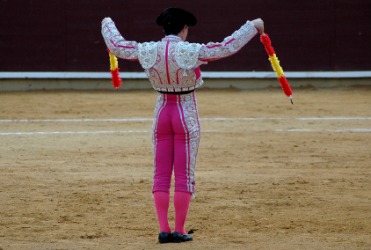Do you know what is the Bullfighting? Personally I don't like too much this face of the Spanish culture. But lot of foreigners are fascinated with this. So i decided write a post.. Bullfighting is a traditional Spanish spectacle that became popular in the XVII century. It's probably one of the most ancient mass entertainments of the world. Actually, bullfights are considered one of the symbols of the Hispanic culture and an art expression.
Bullfighting is considered an art-form and high culture for its aesthetic and traditions. Moreover, it's a metaphor of a fight between mankind (represented by the torero) and the Death, whose symbol is a bull. As such, it's a spectacle full of emotions: people either love it or hate it.
In a bullfight, 3 toreros have to fight against 2 bulls each and, ultimately, kill them. It's always held in the bullring
Additionally, each bullfight is divided into 3 tercios (stages) and lasts for around 20 minutes: tercio de varas, tercio de banderillas and tercio de muerte. Bullfighting in Spain generally lasts between 1.30 h. and 2.30 h. pm.
Stages of a bullfight
 The fight has the exact same structure for every one of the 6 bulls. It begins with the tercio de varas. Then comes the tercio de banderillas. Finally, the tercio de muerte is the time when the matador faces the bull on its own.
The fight has the exact same structure for every one of the 6 bulls. It begins with the tercio de varas. Then comes the tercio de banderillas. Finally, the tercio de muerte is the time when the matador faces the bull on its own.
The tercio de varas starts right after the bull enters the ring. It's the first contact the matador has with the bull and he'll have the chance to observe the its behavior.
 As the bull is encouraged by the matador to attack the horse, the picadores' mission will be to stab the bull's neck. The picador needs to weaken the bull's neck muscles and make it less dangerous.
As the bull is encouraged by the matador to attack the horse, the picadores' mission will be to stab the bull's neck. The picador needs to weaken the bull's neck muscles and make it less dangerous.
During the tercio de banderillas, 3 banderilleros will try to stick 2 poles with a metal point, similar to an arrow, in the bull's shoulders. As a result, the banderilleros' attacks will further weaken the bull's strength making him losing power.
The matador enters the arena alone at the beginning of the tercio de muerte. He carries with him a red cape called muleta, and a sword (estoque). By placing the sword behind the muleta, the matador uses it to entice the bull and to provoke it to charge.
The faena (job) or performance with the muleta is very visual. The faena ends with the estocada or the act of stabbing the bull to death. It's the most difficult task the matador faces in a corrida because he might be gored while performing it.
estocada


No comments:
Post a Comment